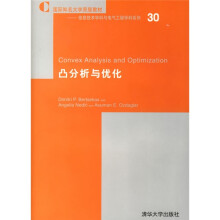国际知名大学原版教材·信息技术学科与电气工程学科系列:凸分析与优化

1. Basic Convexity Concepts
1.1. Linear Algebra and Real Analysis
1.1.1. Vectors and Matrices
1.1.2. Topological Properties
1.1.3. Square Matrices
1.1.4. Derivatives
1.2. Convex Sets and Functions
1.3. Convex and Affine Hulls
1.4. Relative Interior, Closure, and Continuity
1.5. Recession Cones
1.5.1. Nonemptiness of Intersections of Closed Sets
1.5.2. Closedness Under Linear Transformations
1.6. Notes, Sources, and Exercises
2. Convexity and Optimization
2.1. Global and Local Minima
2.2. The Projection Theorem
2.3. Directions of Recession and Existence of Optimal Solutions
2.3.1. Existence of Solutions of Convex Programs
2.3.2. Unbounded Optimal Solution Sets
2.3.3. Partial Minimization of Convex Functions
2.4. Hyperplanes
2.5. An Elementary Form of Duality
2.5.1. Nonvertical Hyperplanes
2.5.2. Min Common/Max Crossing Duality
2.6. Saddle Point and Minimax Theory
2.6.1. Min Common/Max Crossing Framework for Minimax
2.6.2. Minimax Theorems
2.6.3. Saddle Point Theorems
2.7. Notes, Sources, and Exercises
3. Polyhedral Convexity
3.1. Polar Cones
3.2. Polyhedral Cones and Polyhedral Sets
3.2.1. Farkas Lemma and Minkowski-Weyl Theorem
3.2.2. Polyhedral Sets
3.2.3. Polyhedral Functions
3.3. Extreme Points
3.3.1. Extreme Points of Polyhedral Sets
3.4. Polyhedral Aspects of Optimization
3.4.1. Linear Programming
3.4.2. Integer Programming
3.5. Polyhedral Aspects of Duality
3.5.1. Polyhedral Proper Separation
3.5.2. Min Common/Max Crossing Duality
3.5.3. Minimax Theory Under Polyhedral Assumptions
3.5.4. A Nonlinear Version of Farkas Lemma
3.5.5. Convex Programming
3.6. Notes, Sources, and Exercises
4. Subgradients and Constrained Optimization
4.1. Directional Derivatives
4.2. Subgradients and Subdifferentials
4.3. e-Subgradients
4.4. Subgradients of Extended Real-Valued Functions
4.5. Directional Derivative of the Max Function
4.6. Conical Approximations
4.7. Optimality Conditions
4.8. Notes, Sources, and Exercises
5. Lagrange Multipliers
5.1. Introduction to Lagrange Multipliers
5.2. Enhanced Fritz John Optimality Conditions
5.3. Informative Lagrange Multipliers
5.3.1. Sensitivity
5.3.2. Alternative Lagrange Multipliers
5.4. Pseudonormality and Constraint Qualifications
5.5. Exact Penalty Functions
5.6. Using the Extended Representation
5.7. Extensions Under Convexity Assumptions
5.8. Notes, Sonrces, and Exercises
6. Lagrangian Duality
6.1. Geometric Multipliers
6.2. Duality Theory
6.3. Linear and Quadratic Programming Duality
6.4. Existence of Geometric Multipliers
6.4.1. Convex Cost Linear Constraints
6.4.2. Convex Cost Convex Constraints
6.5. Strong Duality and the Primal Function
6.5.1. Duality Gap and the Primal Function
6.5.2. Conditions for No Duality Gap
6.5.3. Subgradients of the Primal Function
6.5.4. Sensitivity Analysis
6.6. Fritz John Conditions when there is no Optimal Solution
6.6.1. Enhanced Fritz John Conditions
6.6.2. Informative Geometric Multipliers
6.7. Notes, Sources, and Exercises
7. Conjugate Duality
7.1. Conjugate Functions
7.2. Fenchel Duality Theorems
7.2.1. Connection of Fenchel Duality and Minimax Theory
7.2.2. Conic Duality
7.3. Exact Penalty Functions
7.4. Notes, Sources, and Exercises
8. Dual Computational Methods
8.1. Dual Derivatives and Subgradients
8.2. Subgradient Methods
8.2.1. Analysis of Subgradient Methods
8.2.2. Subgradient Methods with Randomization
8.3. Cutting Plane Methods
8.4. Ascent Methods
8.5. Notes, Sources, and Exercises
References
Index
1.1. Linear Algebra and Real Analysis
1.1.1. Vectors and Matrices
1.1.2. Topological Properties
1.1.3. Square Matrices
1.1.4. Derivatives
1.2. Convex Sets and Functions
1.3. Convex and Affine Hulls
1.4. Relative Interior, Closure, and Continuity
1.5. Recession Cones
1.5.1. Nonemptiness of Intersections of Closed Sets
1.5.2. Closedness Under Linear Transformations
1.6. Notes, Sources, and Exercises
2. Convexity and Optimization
2.1. Global and Local Minima
2.2. The Projection Theorem
2.3. Directions of Recession and Existence of Optimal Solutions
2.3.1. Existence of Solutions of Convex Programs
2.3.2. Unbounded Optimal Solution Sets
2.3.3. Partial Minimization of Convex Functions
2.4. Hyperplanes
2.5. An Elementary Form of Duality
2.5.1. Nonvertical Hyperplanes
2.5.2. Min Common/Max Crossing Duality
2.6. Saddle Point and Minimax Theory
2.6.1. Min Common/Max Crossing Framework for Minimax
2.6.2. Minimax Theorems
2.6.3. Saddle Point Theorems
2.7. Notes, Sources, and Exercises
3. Polyhedral Convexity
3.1. Polar Cones
3.2. Polyhedral Cones and Polyhedral Sets
3.2.1. Farkas Lemma and Minkowski-Weyl Theorem
3.2.2. Polyhedral Sets
3.2.3. Polyhedral Functions
3.3. Extreme Points
3.3.1. Extreme Points of Polyhedral Sets
3.4. Polyhedral Aspects of Optimization
3.4.1. Linear Programming
3.4.2. Integer Programming
3.5. Polyhedral Aspects of Duality
3.5.1. Polyhedral Proper Separation
3.5.2. Min Common/Max Crossing Duality
3.5.3. Minimax Theory Under Polyhedral Assumptions
3.5.4. A Nonlinear Version of Farkas Lemma
3.5.5. Convex Programming
3.6. Notes, Sources, and Exercises
4. Subgradients and Constrained Optimization
4.1. Directional Derivatives
4.2. Subgradients and Subdifferentials
4.3. e-Subgradients
4.4. Subgradients of Extended Real-Valued Functions
4.5. Directional Derivative of the Max Function
4.6. Conical Approximations
4.7. Optimality Conditions
4.8. Notes, Sources, and Exercises
5. Lagrange Multipliers
5.1. Introduction to Lagrange Multipliers
5.2. Enhanced Fritz John Optimality Conditions
5.3. Informative Lagrange Multipliers
5.3.1. Sensitivity
5.3.2. Alternative Lagrange Multipliers
5.4. Pseudonormality and Constraint Qualifications
5.5. Exact Penalty Functions
5.6. Using the Extended Representation
5.7. Extensions Under Convexity Assumptions
5.8. Notes, Sonrces, and Exercises
6. Lagrangian Duality
6.1. Geometric Multipliers
6.2. Duality Theory
6.3. Linear and Quadratic Programming Duality
6.4. Existence of Geometric Multipliers
6.4.1. Convex Cost Linear Constraints
6.4.2. Convex Cost Convex Constraints
6.5. Strong Duality and the Primal Function
6.5.1. Duality Gap and the Primal Function
6.5.2. Conditions for No Duality Gap
6.5.3. Subgradients of the Primal Function
6.5.4. Sensitivity Analysis
6.6. Fritz John Conditions when there is no Optimal Solution
6.6.1. Enhanced Fritz John Conditions
6.6.2. Informative Geometric Multipliers
6.7. Notes, Sources, and Exercises
7. Conjugate Duality
7.1. Conjugate Functions
7.2. Fenchel Duality Theorems
7.2.1. Connection of Fenchel Duality and Minimax Theory
7.2.2. Conic Duality
7.3. Exact Penalty Functions
7.4. Notes, Sources, and Exercises
8. Dual Computational Methods
8.1. Dual Derivatives and Subgradients
8.2. Subgradient Methods
8.2.1. Analysis of Subgradient Methods
8.2.2. Subgradient Methods with Randomization
8.3. Cutting Plane Methods
8.4. Ascent Methods
8.5. Notes, Sources, and Exercises
References
Index
本书主要作者Dimitri P. Bertsekas是美国麻省理工学院电气工程和计算机科学系的资深教授,他是“动态规划与随机控制”、“约束优化与Lagrange乘子方法”、“非线性规划”、“连续和离散模型的网络优化”、“离散时间随机控制”、“并行和分布计算中的数值方法”等十余部教科书的主要作者,这些教科书的大部分被用作麻省理工学院的研究生或本科生教材,本书就是其中之一。
阅读本书仅需要线性代数和数学分析的基本知识。通过学习本书,可以了解凸分析和优化领域的主要结果,掌握有关理论的本质内容,提高分析和解决优化问题的能力。因此,所有涉足系统分析领域的理论研究人员和实际工作者均可从学习或阅读本书中获得益处。此外,本书也可用作高年级大学生或研究生学习凸分析方法和理论的教材或辅助材料。
阅读本书仅需要线性代数和数学分析的基本知识。通过学习本书,可以了解凸分析和优化领域的主要结果,掌握有关理论的本质内容,提高分析和解决优化问题的能力。因此,所有涉足系统分析领域的理论研究人员和实际工作者均可从学习或阅读本书中获得益处。此外,本书也可用作高年级大学生或研究生学习凸分析方法和理论的教材或辅助材料。
比价列表
公众号、微信群
 缺书网
缺书网微信公众号
 扫码进群
扫码进群实时获取购书优惠






